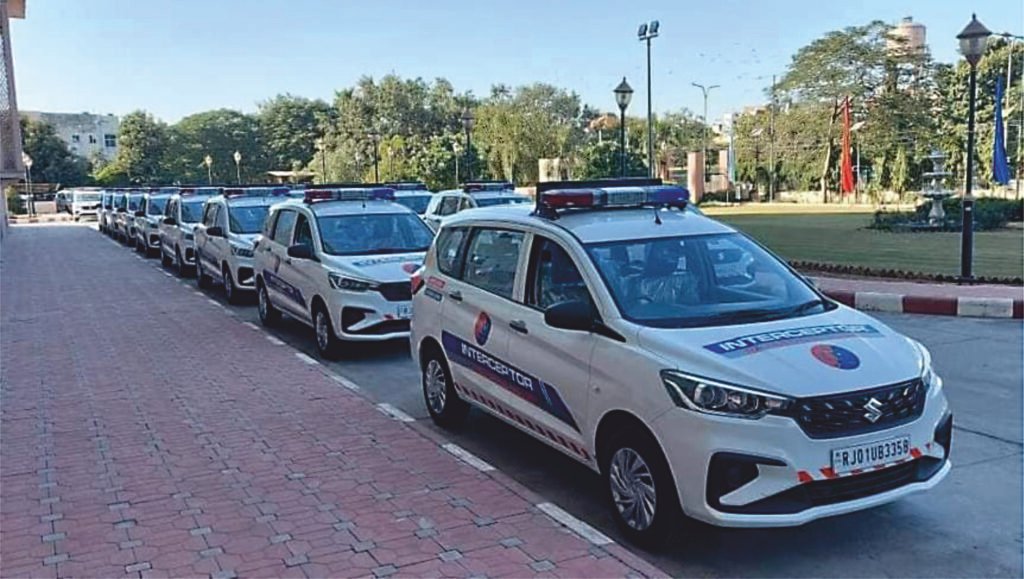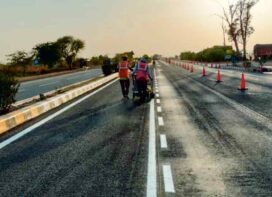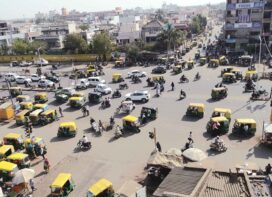
A renewed focus on road safety and traffic violation enforcement in India has led to the introduction of unique technology solutions. Sid Jalan explores one such solution – Vehicle Interceptors – and its deployment in the country.
Indian roads, spread across 63 lakh kms, have become infamous for their lack of safety – often featuring as one of the most dangerous in the world. The ever-increasing number of vehicles, combined with a wide range of road conditions, vehicle categories and driving habits, demands innovative solutions to manage traffic effectively and reduce violations. The Central and various State governments are looking at vehicle interceptors as a new facet of enhancing road safety.
Talking of Interceptors
Interceptor is a mobile traffic solution where enforcement equipment, such as camera and Lidar, is mounted on a vehicle that can be deployed in various locations. These units monitor speed, vehicle number plate and other visuals such as seatbelt usage, triple motorcycle-riding, riding without helmets, wrong side driving, mobile-phone use, bus lane breaches, and much more.

Sanjiv Taneja, CEO and Managing Partner of Integra Design says, “An interceptor is a composite solution that can help enforcement with evidential data, pictures and videos, because in a democratic situation anybody can challenge the ticket that one receives. The evidence must be convincing, unambiguous and un-challengeable with the slew of data that we embed with the digital evidence.”
These mobile units aim to catch many traffic violations and can generate an e-challan for automated enforcement. Vehicle interceptors use Laser Speed Cameras, surveillance cameras 360o view, complete with embedded ANPR (Automatic Number Plate Recognition), Artificial Intelligence (AI) powered edge-detection for vehicle classification detection and a variety of over-the-air digital communication.
Interceptors use this technology to capture infractions that might slip under police radar due to high traffic volume, or to catch repeat offenders who may have learned patrolling patterns and static camera locations. These can ensure consistent enforcement, deter violations, and enhance overall road safety.
The vehicles have been and being further introduced in States across the country, with Maharashtra approving a whopping 187 vehicles in 2023. In recent times, the launch of vehicle Interceptors in Rajasthan, Haryana, Gujarat & Madhya Pradesh are a resounding success, with almost tens of thousands of violations caught in just few weeks of deployment.
Seriously grave injuries are seven times more than reported fatalities, figures disclosed by the Trauma Chief of All India Institute of Medical Sciences in one of the conferences. People end up with disabilities that can impact their quality of life. This is where the role of Interceptors come in.
– Sanjiv Taneja

Madhu Karthikeyan, Managing Director, DataCorp Traffic states, “Different cities and regions in India may have varying approaches to adopting traffic Interceptors, depending on factors such as local traffic patterns, infrastructure & maintenance facility, technical advancement, etc. Many cities have started with pilot programs to test the effectiveness of traffic interceptors in specific areas before implementing them on a larger scale.”
To balance the benefits of data-driven insights with privacy concerns in traffic safety, we employ strict data anonymization, minimise data collection to essentials, and ensure transparency with informed consent. We adhere to legal compliance and security measures, conducting privacy impact assessments. Continuous monitoring and redress mechanisms further protect individual rights while advancing traffic safety.
– Madhu Karthikeyan
Objectives and Role in Traffic Management
Interceptors can overcome the inherent challenges over fixed gantry camera systems, which cannot account for unpredictable locations nor be redeployed to areas with possibly higher requirements during times of the day and night.
“The fixed systems get predictive, they get geo-marked, and you have applications which pre-warn an over-speeding driver about a camera in the next 200 metres or so. A violator therefore, slows down and then speeds up between the two cameras, defeating the very purpose of having these systems reduced to merely expensive speed breakers,” adds Sanjiv.
– As per the IRTE (Institute of Road Traffic Education), Evidence-based Law Enforcement is the one of the main objectives of interceptors. Violators cannot argue the clear evidence of their traffic violations.
– Vehicle Interceptors help manage traffic flow by addressing violations that disrupt the flow of traffic. They can quickly respond to incidents such as accidents, breakdowns, or roadblocks, ensuring that traffic continues to move smoothly.
– The presence of vehicle Interceptors on the road acts as a powerful and effective deterrent to reckless driving. Knowing that law enforcement officers are actively monitoring and enforcing traffic rules encourages motorists to follow traffic regulations, resulting in safer roads.
– By integrating with audio-visual devices, drivers can be made aware of any traffic violations they have caused. This information can also be used for analysis by government and traffic officials.
According to Sanjiv, there is no need for spot enforcement once you integrate these systems to the national platform called NIC-ITMS. The delivery of the evidence to the violator and recovery of challans or fines becomes the domain of the NICs. “We are a union of States so in Rajasthan you will see cars which are from Delhi, Haryana, Chandigarh or Gujarat, how do you enforce those vehicles? The initiative coming through is the ‘One Nation One Challan’, which is an integration of the national database for the delivery of challans across India.”
Road surveys, data, and first response
While the main application of Interceptors is enforcement, it is also being used for surveys and audits. Utilising the on-board camera system, roads and infrastructure can be recorded under different traffic and lighting conditions. This data can be analysed by AI systems to identify any weak points or design issues.
The real-time data collection capability can provide authorities with valuable insights about traffic flow and patterns, directly impacting enforcement strategies. Reviewing the survey-data can help them make informed decisions to influence driver behaviour and reduce accident-prone spots. The data can further help determine the locations and specific timings for deployment of vehicle Interceptors.
Madhu says, “Interceptor’s data can be shared with traffic management systems to make real time adjustments to improve traffic flow. The data can also be analysed, alongside other traffic data, to enable predictive analytics that anticipate potential traffic incidents or violations, allowing authorities to take preventive measures. Information from Interceptors can be used to identify areas with high violation rates, allowing for the implementation of traffic calming measures like speed bumps, signage, or enhanced enforcement in those areas.”
Interceptors can also act as a first response team, as their mobile nature increases the probability of being near a crash site. In this scenario, the vehicle can stop any enforcement actions and switch to first-aid intervention, while paramedics and fire-response teams are enroute.
The challenges
Madhu states that Challenges can include infrastructure compatibility, resource allocation, public acceptance, addressing behavioural differences and other technical needs, requiring tailored approaches for each city.
While vehicle interceptors are crucial for maintaining road safety, they face challenges that can impact their effectiveness.
Resource Limitations – Adequate resources are essential for efficient operation of vehicle Interceptors. This includes not only the vehicles themselves but also the necessary infrastructure, communication equipment, maintenance, and training. Budget constraints can limit the number of Interceptors deployed and their capabilities.
Maintenance Issues – Like any other vehicles, Interceptors require regular maintenance to ensure they function correctly. Mechanical issues or equipment malfunctions can disrupt operations, emphasising the need for a robust maintenance schedule.
Staffing Constraints – The effectiveness of vehicle Interceptors depends on the availability of trained personnel to operate them. Staffing constraints, including shortages of qualified officers, can limit the coverage and response times of Interceptors.
Data – As vehicle Interceptors are constantly recording, this can lead to privacy and data concerns, especially without any stringent government regulations. The need for cyber-security and strong communication protocols can further add to the running costs of these systems.
Future trends
The future of vehicle Interceptors in India holds promise, with advancements in technology and strategies for road safety. Sensitivity and effectiveness of devices is also expected to improve, which can further help with deployment based on unique city requirements and infrastructure.
Even Artificial intelligence (AI) is increasingly being integrated into traffic monitoring systems, where these algorithms can analyse traffic patterns, detect violations in low-light conditions, and provide real-time data to enhance efficiency. Advanced data analytics tools can help law enforcement agencies develop targeted interventions.
“AI enhances the automation process of Interceptors from monitoring traffic, capturing violations to generating e-challans,” says Madhu. “AI algorithms can improve accuracy of vehicle detection and number plate recognition, analyse vast amounts of real time data, patterns and trends to identify accident-prone areas and give valuable insights to authorities.”
At the moment, violations still need to be validated by a centralised server. However, the complete automation of the citation process seems likely, thereby reducing paperwork and administrative intervention. Vehicle Interceptors will be further integrated with smart traffic management systems to reduce costs and the burden on resources.
Taking about AI Sanjiv adds – “AI is already well in place when it comes to camera systems. However, AI is all about training the algorithm. There are various algorithms available today and we need to train them with millions of pictures – Different vehicle types, assorted number plates, faces, complexions, shapes, sizes, seatbelts status, helmet status, etc. We need to train the AI on identifying what is right and wrong. AI can be applied to more than 55-60 violations in the Motor Vehicle Act, where it can measure, analyse and help identify violations.”
In the dynamic landscape of India’s roads, vehicle Interceptor’s efforts in enforcing traffic laws, monitoring speed limits, and detecting violations can contribute to reducing accidents and fatalities. While challenges persist, the commitment of law enforcement agencies, ongoing training, and the embrace of technology can potentially lead to a safer and more responsible driving culture.
 TrafficInfraTech Magazine Linking People Places & Progress
TrafficInfraTech Magazine Linking People Places & Progress


